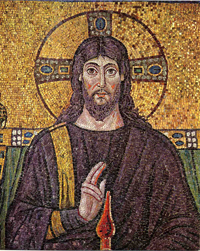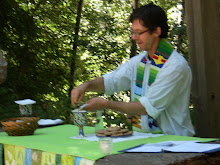God brought Jesus back to life—this is the pivotal event of
history. But it is not a historical
event in the same way the Battle of Waterloo is, or the signing of the Magna
Carta. Because the resurrection of Jesus
is ongoing. Easter morning was the
continuation of the work of Jesus’ life, of bringing others back from physical,
or moral, or spiritual death. And it
was also the beginning of a process of renewing the life of the whole creation,
a process that is ongoing in our present and is our hope for the future. God is bringing Christ to eternal life in us,
and this is ongoing, and gradual, and happens in different ways and at
different times for different people.
Which is what today’s text from the Gospel of John is
about. The story of Thomas shows us ourselves,
and how it is that we come to know and to live Jesus’ resurrection. The process can’t occur without our
participation, but just for that reason it is something of a problem. Because we aren’t always sure it’s what we
want, or how to do it? In part it is a
question of evidence—how can I affirm what I do not believe, and how can I
believe what I have not seen or touched or experienced for myself?
It is also a problem of recognition. We may feel like we can see evidence in our
lives, or in the world around us, for the living presence of the Spirit, or of
God, but it is not always clear what these have to do with a man who lived
2,000 years ago. In what sense are they
signs of Jesus?
Finally, there is the question of action, or practice. When I am asked whether I believe in the
Resurrection, isn’t this a question about the way I live and act, about what I do?
Today’s gospel story addresses all these aspects of the
problem, and it does so in the way it describes the risen body of Jesus. It is a remarkable body, one that passes
instantaneously through locked doors, one whose physical breath is the Holy
Spirit of God, the kind of body that speaks of a transformation in which it has
become something more than human.
And yet this body bears the marks of crucifixion, and this is
precisely what makes it recognizable as Jesus.
It is in his demand to see the marks of Jesus’ wounds, and to put his own
fingers in the places where the nails pierced his hands, and in the opportunity
that Jesus graciously provides to do just that, that Thomas knows the
truth. But Thomas is not alone. John says explicitly that this story is
written for us, so that we also may believe.
So I don’t think it is stretching the point to say that this story’s
message is that it is in touching the wounds of Christ that we come to know and
to believe that he is our Lord and our God.
Now, when I say “the wounds of Christ,” there is probably at
least one person here in this room who thinks about guilt. Centuries of Christians have thought this
way, meditating on the crucified body of Jesus and feeling responsible for his
wounds, because of our own sins. And that isn’t such a bad practice—for Lent. But
the body in this story is the resurrection body, and these wounds are not bleeding
accusations of guilt and judgment, but openings—to insight, to reconciliation
and peace, to awe and gratitude, joy and faith.
Maybe the wounds of the risen Lord are the places where the work
of Jesus is still open, still unfinished.
They invite our exploration and participation, because we also are
unfinished. Christ’s resurrection is
still not a reality in our lives and in the world because we have been afraid,
or unwilling, to see and to touch his wounds.
We struggle to affirm that Jesus is Lord, because we don’t
see the evidence. But what if that
longing for direct, personal knowledge of God, that sense of missing the most
important thing, that nagging dissatisfaction with a superficial, conventional,
and materialistic approach to life, that hunger for something more vivid, more
meaningful, more enduring and true—what if that wound was the evidence?
We may wonder what this longing has to do with Jesus, or with
the church that claims to do what it does in his name. But maybe this itself is an opening, an invitation
to feel our way into Jesus’ own pain over religion. He experienced the immediate presence of the
Kingdom of God, and then he looked at the indifference and hypocrisy of the religious
leaders of his day: their sterile rehashing of old arguments, and quibbling
over minor differences of interpretation; their pursuit of worldly power and
prestige, and easy accommodation to corrupt and violent elites; their contempt
for the outcast, the poor and the mentally and physically disabled, and
inordinate focus on petty offenses and sexual sins. Jesus saw this and was wounded with anger,
and with a burning compassion for the sufferings of God’s people. We could turn away from the corresponding
problems of religion today, as so many people do, and say “that’s someone else’s
problem,” but then there would be no opening for us in the risen body of
Christ, only a old and fading scar.
And when we think about how we are to practice, how to live in
a way that is consistent with Jesus’ compassion, and his urgency for the
Kingdom of God, we often assume that this a question of knowing what to do. But here also we might find greater freedom
and power if we understood that here, too, there is an open wound. We
think of Jesus as supremely sure of himself and his plan, so we forget how
often he had to go off by himself to pray for guidance and for strength. We forget his prayer in the garden that the
cup of betrayal and suffering should pass from his lips, but that, in the end, “your
will, O Lord, not mine, be done.”
Last night, I attended, along with some members of our
congregation, and several hundred others, a celebration of the ministry of the
Reverend Tim Kellgren, who is retiring today, at the end of this morning’s
services, after 37 years as pastor at Elim Lutheran Church. There was a lengthy after-dinner program of
songs and remembrances and tributes, and many people made mention of the ministries
that Pastor Tim and the Elim congregation helped to found that have had a
transforming impact on this community and the world. These include PEP, providing subsidized
senior housing, COTS and the Petaluma Kitchen, sheltering homeless persons and
helping them get back on their feet, Petaluma Bounty and the Interfaith Food
pantries, that feed the hungry. But for
me it was also inspiring, and encouraging, to hear passing mention of the many false
starts, the big ideas that never got off the ground, or were attempted, but later
given up as impractical, or just too difficult to sustain.
Maybe we bring Christ to life not when know what to do, but when
we know that we are sent, as Jesus was sent, and go in his peace and try
something, anything, to touch the wounds of the world. And in this we could ask for no better patron
saint than Thomas. In the popular
imagination, Thomas is most associated with his doubts about the resurrection. But the Gospel of John also depicts him as the
apostle of courageous action. When Jesus
announces he is going back to Judea, to the grave of his friend Lazarus, the
other disciples say, “Rabbi, they were just seeking to stone you, and are you
going there again?” But Thomas is the
one who says “Let us also go, that we may die with him.” And when
the rest of them were hiding out after Jesus’ crucifixion, with the doors
locked, and the lights out, and the shades drawn, Thomas wasn’t there. So where was he? Out and about, abroad in the city? I can imagine him saying, “This is
crazy. We can’t just cower here in fear
forever. Life has to go on—the Sabbath
is over, I’m going to the market to get us some bread.” In church tradition, Thomas is the apostle
who went the furthest to spread the Gospel.
Others went to Syria, or to Asia Minor, or even to Rome, but Thomas, it
is said, went to India, and died a martyr’s death there.
Maybe for some people discipleship begins with believing in
the resurrection, and moves from there to recognizing the wounds of Christ, and
then to doing something about them. But for
Thomas it works in reverse. His story
suggests that we first should overcome our fears, and just try something,
anything to touch the wounds of Jesus. Then,
maybe, our doubts will begin to fall away and we will be able to cry, with the
joy of firsthand experience, “My Lord and my God!”




